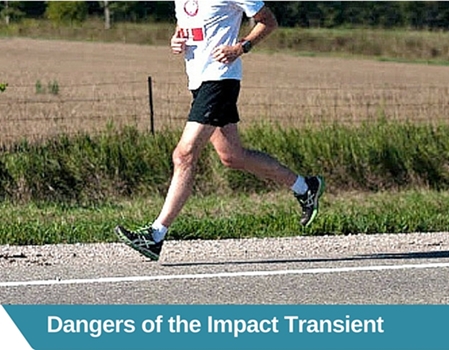A hallmark feature of heel strike running is the impact transient which occurs at the beginning of the ground reaction force and is generated at heel strike. By comparison, forefoot running produces a ground force, but the impact transient is absent [1], which may suggest why runners have better luck with injury prevention after they’ve switched to forefoot running.
Why The Impact Transient Hurts
The video below is from the famous Harvard study by Dr. Daniel Lieberman which compared the kinematics of a heel strike and a forefoot strike landing, and shows how heel striking generates an impact transient.
- Some experts believe the heel strike-induced impact transient is equivalent to taking a hammer and driving a force 3-times your body’s mass directly into your heel which then travels up the leg and into the back.
The More You Weigh, The Greater the Impact Transient
Ultimately, the biggest problem with heel strike running is the impact transient. Think about it: a force 3-times your body’s mass bolting straight up your body. And, the more you weigh, the greater the impact transient –only makes sense.
No wonder why heavier people are afraid to run- if they ran with a heel strike, their chances of injury increases than if they ran with a forefoot strike. (Here’s how forefoot running is safer than heel strike running for obese runners)
Although, forefoot running may have its critics, the forefoot running style has been an accepted treatment for debilitating lower leg injuries such as chronic exertional compartmental syndrome.
Finally, more studies are needed to assess the role of the heel strike impact transient in causing injury and to show the key mechanical parameters that allows heel strike running to be dangerous.
More From Run Forefoot:
Patellofemoral Pain Syndrome – Many runners suffer this dreaded injury, but many runners don’t know why. This article covers the main cause of knee injury in runners.
Achilles Heel – Found out why heel strike running is such a daunting task for the Achilles tendon, resulting in injury to the tendon.
Eccentric Exercises – We often hear about eccentric exercises, but you can achieve them just by running barefoot; find out how.
Forefoot Shoe Review – Read my review on the FeelMax Osma 2, an under-appreciated forefoot running shoes that is a great tool to help you mechanically run your best.
Also, be sure to head over to the Run Forefoot Facebook Page, it’s a great place to ask questions about forefoot running, barefoot running and footwear. I’ll be happy to answer them for ya!
References:
[1]. Lieberman et al. Foot strike patterns and collision forces in habitually barefoot versus shod runners. Nature, 2010; 463(28):531-535
Bretta Riches
BSc Neurobiology; MSc Biomechanics candidate, ultra minimalist runner & founder of RunForefoot. I was a heel striker, always injured. I was inspired by the great Tirunesh Dibaba to try forefoot running. Now, I'm injury free. This is why I launched Run Forefoot, to advocate the health & performance benefits of forefoot running and to raise awareness on the dangers of heel striking, because the world needs to know.
Latest posts by Bretta Riches (see all)
- Can You Run In Barefoot Shoes? Yes, But DON’T Heel Strike! - 21/07/2024
- Why Cushioned Running Shoes Are Really Bad for Your Feet - 19/07/2024
- Do Cushioned Running Shoes Cause Injuries? - 17/07/2024


Leave a Reply